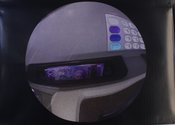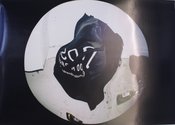John Hurrell – 31 December, 2018
Rump plays on the transparency of the glass to cause spatial confusion with the different depths, scales and juxtapositions. He also plays on the viewer scanning the rows or columns of joined up prints, moving from one vector to another, with a horizontal 'painting' format alongside vertical filmlike columns of images; plus looking through with looking at.
Auckland
George Rump
Still-Life Pictures
14 December 2018 - late February 2019
In this unusual Window show in the university library foyer, the door to the glassed off partition is open and viewers are invited to physically enter the what-is-normally a closed-off space, to examine George Rump’s photographs via intimate proximity. The works are on the back wall, on the front glass itself, and on the thick glass door (which contains fluorescent tubes). Sometimes they are framed, but mostly they are enlarged prints, the sections arranged in grids-attached directly to the glass-or butted together in a horizontal row, attached to the back plane.
Rump plays on the transparency of the glass to cause spatial confusion with the different depths, scales and juxtapositions. He also plays on the viewer scanning the rows or columns of joined up prints, moving from one vector to another, with a horizontal ‘painting’ format alongside vertical filmlike columns of images; plus looking through with looking at.
The format of the lens Rump uses is circular—a fish-eye—as if peering through an apartment door’s security peek-hole or photographed by a type of distorting surveillance cam, the circle centrally set in the black rectangle of the paper. The colour spectrum is harshly artificial and cold—as if taken at night or in clubs: a strange bluey light—while the subject matter is intimate. Rump presents a silhouetted (shadowlike), rectangular, self-portrait and an image of a baby—possibly a relative of the artist—and shots of friends dancing. And lots of interior hallways and staircases, mingled with views of tagged street fronts, getting cash from ATM machines in the UK, abandoned beer bottles and heavy knapsacks.
Rump sees the round format of the lens as a symbolic tunnel burrowing through the past, a capturing of static slices of time, fleeting fragmented memories surrounded by a black void of forgetfulness.
Does one need a literary trope like this, I wonder (another is a hand holding a lolipop, referencing perhaps the consumerism of art), to enjoy these images? Their optical peculiarities (the distortions and weird colours) seem sufficient to keep one engrossed. In some ways, as frozen ‘time worms’, Rump’s motives and the physical attributes merge, for there is an early sixties feel here, reminiscent of certain LP sleeves for bands like The Byrds and The Rolling Stones, while the colour is reminiscent of the ambience of student flat parties of the time, when black lights (with an ultraviolet spectrum) were popular. Strange convex ‘discs’ using different layers, hinting at another era.
John Hurrell











 Advertising in this column
Advertising in this column Two Rooms presents a program of residencies and projects
Two Rooms presents a program of residencies and projects



This Discussion has 0 comments.
Comment
Participate
Register to Participate.
Sign in
Sign in to an existing account.